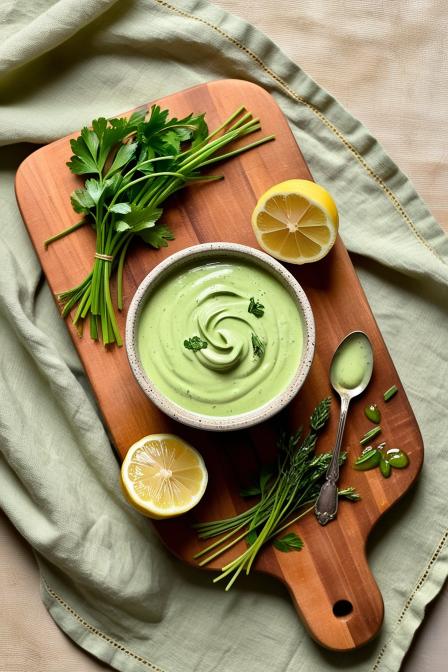Ever tasted something so green it made your mouth feel like spring? That’s what Green Goddess Dressing does when it’s made right. Not bottled. Not muted. I mean really made—blitzed fresh in your blender, bursting with bold herbs and silky tang. I was 19 the first time I dipped a wedge of crisp romaine into a chilled bowl of homemade green goddess, and it tasted like a forest throwing a dinner party. Been hooked ever since.
There’s a reason this dressing’s had a cult following since the 1920s. It’s creamy, punchy, herby, a lil’ briny… and downright magical when done from scratch. Not just for drizzling over salads—oh no. This is a sauce that wants to dress up roasted chicken, spoon over grilled salmon, or be swiped up with crusty bread at 10pm while standing at the fridge. Been there. Many times.
Let’s get into it. What makes Green Goddess so special? Why do folks keep bringing it back, decade after decade?
What Is Green Goddess Dressing?
Green Goddess Dressing is a creamy, herb-forward dressing with roots going back to the Palace Hotel in San Francisco, circa 1923. It was originally whipped up to honor an actor (no joke), and somehow, it’s still going strong a hundred years later. Talk about staying power.
It’s traditionally made with mayonnaise, sour cream, anchovies, lemon juice, and a heap of fresh herbs—tarragon, parsley, chives. Over time, it’s morphed a bit. Avocado sometimes sneaks in. Greek yogurt makes appearances. Some folks toss in basil or cilantro. And honestly? The flexible nature of this dressing is what makes it such a staple in any serious cook’s rotation.
But what makes homemade Green Goddess dressing truly shine isn’t just freshness. It’s the layering. The balance. The way you coax flavor out of each herb, soften the sharpness with dairy, and lift the whole thing with acid and umami. When done well, it’s not just a condiment. It’s the star.
Ingredients & Smart Substitutions
Let’s be honest—bad herbs make bad dressing. No one wants limp parsley or a wilting bunch of cilantro dragging the whole thing down. Get the good stuff. Wash and dry it properly.
Here’s the full list, plus pro swaps if you’re short on anything:
🧾 Green Goddess Dressing Ingredients & Substitutions
| Ingredient | Purpose | Substitutions / Notes |
|---|---|---|
| Fresh parsley (½ cup) | Earthy herb base | Use flat-leaf for better flavor than curly |
| Fresh chives (¼ cup) | Mild oniony punch | Sub green onions (tops only) if needed |
| Fresh tarragon (2 tbsp) | Anise flavor, traditional herb | If unavailable, sub with a tiny pinch of fennel fronds |
| Fresh basil (¼ cup) | Sweet, bright depth | Optional, but adds a summery lift |
| Anchovy fillets (2) | Umami backbone | Sub with 1 tsp anchovy paste or 1 tsp miso for veg version |
| Garlic (1 small clove) | Sharp bite | Use roasted garlic for milder flavor |
| Lemon juice (2 tbsp) | Acidity, brightness | White wine vinegar works in a pinch |
| Greek yogurt (½ cup) | Creaminess with tang | Sub sour cream or crème fraîche |
| Mayonnaise (¼ cup) | Rich texture and fat | Can sub with more Greek yogurt for lighter version |
| Avocado (½, ripe) | Smooth texture, subtle flavor | Optional, but makes it creamier and greener |
| Salt (½ tsp or to taste) | Enhances everything | Start small, adjust later |
| Black pepper (to taste) | Warmth and balance | Cracked fresh is always better |
Why Fresh Herbs Matter
Don’t mess around here. Dried parsley and chives? Might as well toss the whole bowl. Fresh herbs bring volatile oils and aromatics that don’t survive drying. Their green punch is what makes this dressing sing.
If you have to use something dried (say, tarragon), keep it minimal and steep it in lemon juice first to help soften the bite.
Step-by-Step Instructions (with Pro Tips)
Alright. Let’s get our hands dirty. The beauty of this dressing is how fast it comes together—but a few tweaks make all the difference.
🥣 How to Make It:
Step 1: Prep Your Herbs
Wash all the herbs gently under cold water. Pat dry thoroughly with a clean towel or spin ’em dry if you’ve got a salad spinner. Moist herbs = watery dressing = sad day.
Step 2: Add Everything to the Blender
Toss in parsley, chives, tarragon, basil (if using), anchovy, garlic, lemon juice, Greek yogurt, mayo, and avocado.
Step 3: Blend Until Smooth
Pulse a few times to break it up, then blend on high until creamy and bright green. You want it smooth, not chunky.
Step 4: Season and Adjust
Taste it. You might need more salt, lemon, or a splash of cold water to thin. Let your tongue be the boss here.
Step 5: Chill
Let it sit in the fridge for at least 30 minutes before serving. This lets the flavors marry and mellow out. It gets better with a lil’ nap.
💡 Expert Tips:
- Too thick? Add a tablespoon of cold water or extra lemon juice to loosen.
- Too sharp? Add a bit more mayo or avocado to mellow.
- Color dulling? Blend herbs with cold ingredients to preserve brightness. Warm blades = brown dressing.
Common Mistakes to Avoid:
- Over-blending: This can bruise herbs and dull the green.
- Using old herbs: Flavorless and flat. Always go fresh.
- Not chilling it: Fresh out of the blender, it’s loud and unbalanced. Give it time to bloom.
Variations You Might Try:
- Vegan: Sub mayo and yogurt with vegan versions, swap anchovy for white miso or capers.
- Spicy: Add 1 jalapeño (seeded) or a pinch of cayenne.
- Nutty: Toss in a tablespoon of pistachios or walnuts for richness.
- Zingy: Try sherry vinegar in place of lemon for a punchier profile.
Cooking Techniques & Kitchen Science
Even though this is a no-cook sauce, technique matters. Let’s geek out for a sec.
🧪 Why We Blend in This Order
Anchovies, garlic, and lemon go in first. They need more blitzing to break down fully. Herbs go in after to avoid over-processing and dulling. Mayo and yogurt should always go last to preserve their texture.
🧊 Storage & Shelf Life
Store in a glass jar with a tight lid. It keeps in the fridge for up to 5 days—though it’ll lose brightness by day 3. Don’t freeze it. The herbs get weird, and the emulsion breaks.
♨ Reheating?
Nope. You don’t. It’s meant to be cold. Warm it, and it’ll separate and wilt the flavor.
🛠 Tools You’ll Want
- High-speed blender or food processor: Essential for silky-smooth texture.
- Rubber spatula: For scraping down the sides—don’t waste the good stuff.
- Citrus press: Makes juicing lemons much easier and cleaner.
Serving & Pairing Suggestions
Okay, here’s where it gets really fun. Green Goddess isn’t just for salad.
🥗 What It’s Great On:
- Grilled chicken thighs or skewers
- Roasted salmon or trout
- Hearty grain bowls (think quinoa + chickpeas + roasted veg)
- As a dip for raw veggies, pita, or chips
- Spread on sandwiches or inside wraps
- Spooned over poached eggs on toast (yes, do it)
For salad lovers, try it over butter lettuce, little gem, or shaved fennel and radish. Anything crisp benefits from this creamy coat.
🍷 Pair With:
- Sauvignon blanc or a grassy Grüner Veltliner
- Sparkling water with lemon
- Light pilsners or wheat beers
- Bright, citrusy cocktails (gin + cucumber + mint = wow)
Best Time to Serve This
Summer. Spring. Heck—even winter if you’re craving freshness. It’s cool, refreshing, and makes heavy dishes feel lighter. Serve it as part of a brunch spread, weeknight dinner, or as a show-off sauce at a dinner party.
Honestly, this stuff shines when everything else feels tired.
Conclusion: Why You’ll Keep Making This Again (And Again)
This dressing’s not just a relic from hotel menus and California cafes. It’s a tool. A flavor bomb. A secret weapon in your culinary stash. Once you nail your version—and you will—you’ll find excuses to slather it on anything that’ll hold still.
It teaches you about balance. About how fresh herbs don’t need to shout when they’re supported right. About layering flavor—not with fancy tricks, but with care and good ingredients.
My final advice? Double the batch. You’ll regret it if you don’t.
FAQs
1. Can I make Green Goddess dressing vegan?
Absolutely. Use vegan mayo and plant-based yogurt, and swap anchovies for white miso, capers, or a dash of tamari for umami.
2. How long does it last in the fridge?
Usually 3–5 days. But the freshest flavor comes within the first two days. After that, the herbs start to dull and the brightness fades.
3. Can I freeze it?
Nope. The emulsion breaks, and the herbs get mushy and brown. Best kept cold but not frozen.
4. Is this dressing healthy?
Depends on your goals. It’s full of healthy fats, protein (if you use Greek yogurt), and fresh herbs. Lighter than ranch, richer than vinaigrette.
5. What if I don’t have tarragon?
Skip it or sub in a little fennel frond or dill. It changes the flavor, but not in a bad way. Make it your own.
Want it extra creamy? Add more avo. Want it zingier? Squeeze in extra lemon. This dressing doesn’t punish you for playing. It rewards you. And that, my friend, is good cooking.

